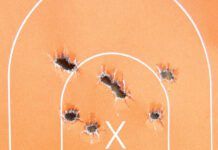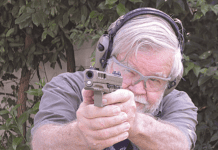Re “Three More 10mm Autos: Kimber, Dan Wesson, Tanfoglio,” May 2017
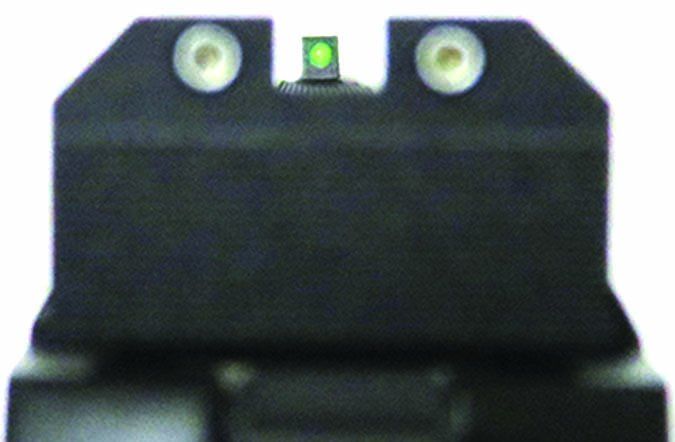
In the technical module about the Dan Wesson Bruin Bronze 1881 10mm pistol, there is the statement, “The Dan Wesson front sight uses a fiber optic to charge up a tritium dot.” While it is true that some “glow in the dark” items collect light energy when illuminated and then glow in the dark for a while, that has nothing to do with how tritium sights work. The tritium sights glow because tritium gas (the radioactive isotope of hydrogen) is sealed in a small, gas-tight hollow glass bead, along with a substance that glows when struck by the radioactive particles given off by the tritium. The bead is not “charged up” by light; it continues glowing as long as the radioactivity lasts, regardless of outside conditions. I’m not sure what the fiber-optic element in the sight does, but is not there to keep the tritium sight charged. The article was quite good otherwise, although I doubt any article would get me to buy a 10mm pistol.
— Leonard
Thank you, Leonard. We agree the 10mm pistols are an acquired taste. Fiber-optic sights, paired with tritium night sights, create a consistently bright sight picture, day or night. In glaring daylight, tritium sights’ relatively small light output won’t be much help to the shooter, but ambient light hitting the fiber optics make them brighter and easier to see. As ambient light diminishes, the fiber optics get less bright, and the tritium sights will become relatively easier to see in low-light and dark conditions.
— Todd Woodard
Choosing Between SIG and Kimber
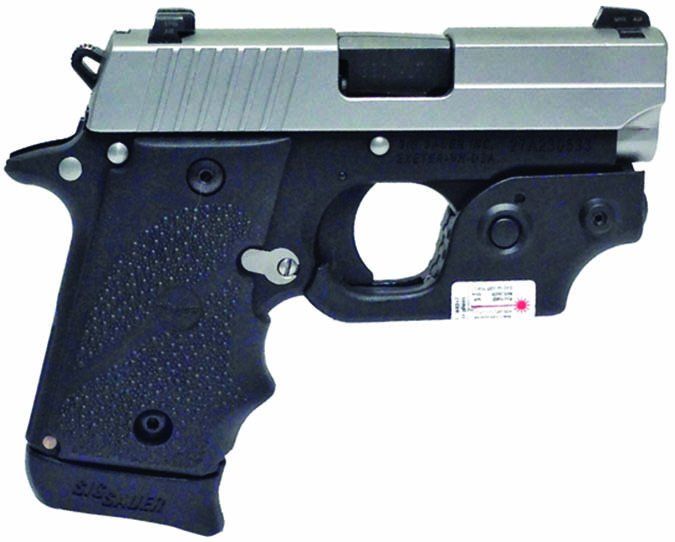
I have recently subscribed to Gun Tests and enjoy reading it when it arrives. One or two issues back, you were testing some SIG Sauer handguns, which provoked my curiosity, although my gun was not specified. I have a SIG P238 380 Auto with decorative finish which I love. However, I really wanted a red-dot sight. At the time I purchased my gun, it would have become a bulky nuisance because of how it had to be mounted. I carry it when I handle large amounts of money (which is frequently) or any time risk is apparent. Most people think it is a cellphone because I have a Sneaky Pete holster. I have a CCDW permit and have had the associated training. I am now wondering if I should consider the new Kimber Micro Nine Crimson Carry with Crimson Trace Grips. I have no way to compare the two guns, either in performance or price, so I thought an email to you might help me decide. As a matter of interest, my SIG has been admired by several friends and associates, so I would not have problem with selling it, should I choose to. It has had exactly one regular box of ammo fired through it.
— John
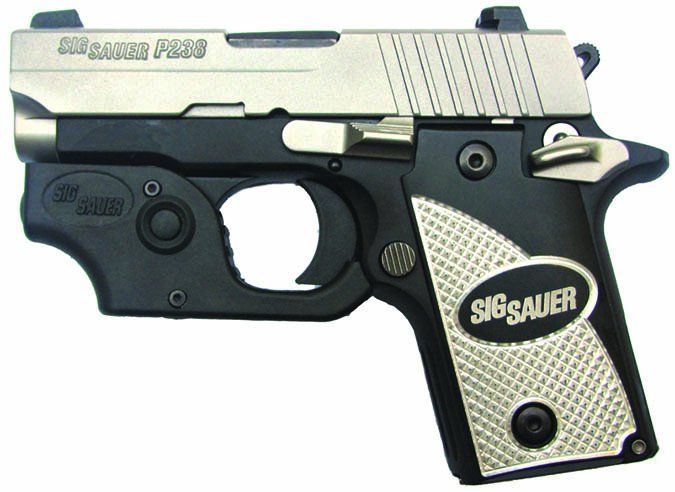
Hey John: We haven’t compared those two guns head to head, so I can’t offer any advice about switching. However, I can relate what we’ve said in the past about the SIG P238 in various configurations. In the November 2014 issue, we tested the SIG Sauer P238 238-380-NBS12 380 ACP, $710, and gave it a C grade. From the review: “Based on our history with this line, this gun was a disappointment. Its control set should have produced a 1911-like functional experience, but the inconsistent trigger pull affected accuracy. We loved the feel of it, but the rubber grips would affect the draw if it’s not in a holster. The laser is included in the price, and that optic helped accuracy.” This particular handgun came with a nice leather holster to accommodate the laser, which was mounted on the trigger guard. In that test, we preferred the Glock 42: “For a retail price at or below $440, we’d buy a Glock 42 Subcompact Slimline and add the Viridian R5-G42 Reactor Green Laser, $239. The G42 was big enough to shoot well and small enough to hide well. With the laser, it was very accurate. The controls, takedown, and maintenance are so easy an Austrian could do it. Would we buy the G42 by itself? Probably not.” We tested another laser-equipped P238, the SIG Sauer P238 Tactical Laser No. 238-380-TL 380 ACP, $829, and gave it a B- grade in the February 2013 issue. We said: “1911 aficionados like the P238 for its trigger and laser activation. It was the best of the bunch in those functions. Ease in concealment took slightly more effort than the others.” A Ruger LCP-LM No. 3718 380 ACP, $443, won that test.
However, if you’re looking for a 380 Auto, we compiled a list of these firearms in a Value Guide in the October 2015 issue. From that list, here were the top-ranked items: Kimber Micro Carry Advocate Brown (September 2015, Grade A-); the Ruger LCP-CT (January 2014, Grade A-), the Ruger LC380 No. 3219 (June 2013, Grade A-), and the Taurus 738B (January 2011, Grade A-).
More On Fake Law
Tacticalgear.com

Hi Todd: When researching the latest ruling to uphold the Maryland Assault Weapons Ban, I came across your “Fake Law” editorial in the April 2017 issue.
With the complexity of the original 2013 law, it’s difficult for the average reader to fully understand what exactly it prohibits. To simplify this for our customers, our team at TacticalGear.com created an infographic that breaks down the different combinations of weapon features that are prohibited in the state of Maryland.
I’m sure your readers would also benefit from this simplified visual aid! Thanks so much for your time and consideration.
— Rhonwyn@TacticalGear.com
Thank you. I’ve attached a sample to encourage readers who are affected by the ban to go take a look at its features. — tw
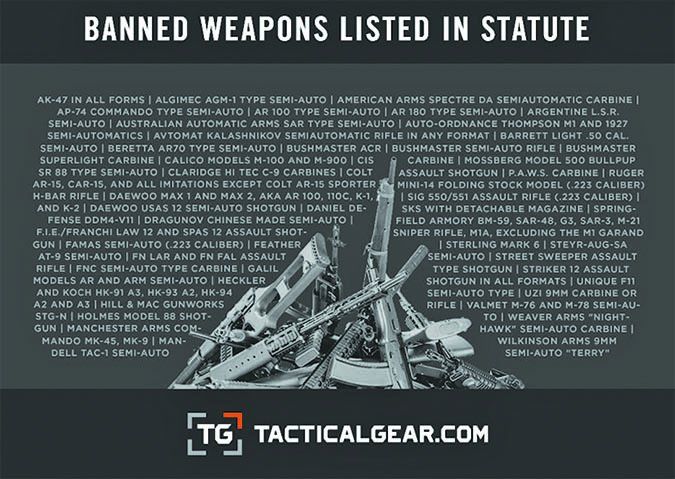
Tacticalgear.com
Todd Woodard’s “Fake Law” editorial was right on the mark. How is it that so many people, including jurists, miss the point of the 2nd Amendment? Any militia needs to be militarily effective. The 2nd Amendment seeks to ensure that the American public will be able to stand up to a tyrannical government. To do that, we need the same kinds of weapons. They have “assault rifles,” so we need to be able to buy and own “assault rifles.” Thanks for all your efforts.
— Peter
Proposes Flattened Grading Scale
Dear Sir: I have been a subscriber for many years. I am also a quality engineer. I wish to take issue with you about the rating system used by the magazine. I refer (only as an example) to “Affordable 1911 Rail Guns.” In that article, GT reported its experience with four new 1911s. An ATI had to be returned to the factory for repair. The trigger was too heavy to be usable (14) pounds. This is a new out-of-the-box gun. It was rated D. It should have been rated F. A new out-of-the box should be ready for its intended use. It should not have any flaws requiring return to factory. The EAA had a problem with either magazine sensitivity or the magazine latch. It was rated B-. It should have been rated F. A new out-of-the box handgun should be ready for its intended use. Rock Island was okay except for an non-ambi safety. It was rated A and ready for its intended use. Springfield Armory was okay, and it was rated A- and ready for its intended use.
As a quality engineer, I can tell you that simple mechanisms like a 1911 should never be allowed to escape from the factory and end up in your hands. But GT sure seems to get numerous examples of almost completed manufacturing and tested firearms. That it does indicates the manufacturer has a marginal or no quality-control system. I assure you that if the manufacturer isn’t testing for simple operation of their product they aren’t testing for metal treating or spring temper, etc., either. They rely on the buyer to do the testing and then try to fix the reported problems on warranty.
Virtually every issue of GT discovers a problem, requiring the test gun be returned to the factory at a significant cost to the buyer. This should earn an automatic “F” rating. Consider the difference in complexity of a modern automatic transmission and a 1911 pistol. Have you ever heard of anyone who had to return a new-car automatic transmission to the factory? Why is that? A 1911 has a handful of parts. An automatic transmission has hundreds of parts.
Your rating system should only have four levels of quality: A+, A, A-, and F. Who would buy a gun rated B; C; D; or F? No one who is sane. A gun should come out of the box and be perfect. A rating below A- indicates poor quality control.
Frankly, I don’t care when GT reports a grade of C and or why the gun got rated that way. I want an “A” gun. I am sure every one of your readers feels the same way. I suggest that the rating system be changed. Then Gun Tests will become more useful to its readers.
— Larry
Hey Larry: By publishing your note, I’ll ask the other readers what they think. We don’t mind failing guns at all, and it is odd that we find so many that are flawed, even if we differ on how to score those flaws. Also, I have had a lot of mail over the years saying we should just abolish the grading and report the outcomes of the test. — tw



